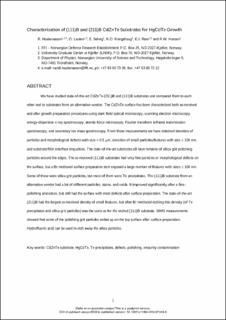| dc.contributor.author | Haakenaasen, Randi | |
| dc.contributor.author | Lauten, Oda | |
| dc.contributor.author | Selvig, Espen | |
| dc.contributor.author | Kongshaug, Kjell Ove | |
| dc.contributor.author | Røer, Eivind Jülke | |
| dc.contributor.author | Hansen, Runar Wattum | |
| dc.date.accessioned | 2021-01-14T09:04:59Z | |
| dc.date.available | 2021-01-14T09:04:59Z | |
| dc.date.created | 2019-10-01T12:11:04Z | |
| dc.date.issued | 2019 | |
| dc.identifier.citation | Journal of Electronic Materials. 2019, 48 (10), 6124-6137. | en_US |
| dc.identifier.issn | 0361-5235 | |
| dc.identifier.uri | https://hdl.handle.net/11250/2722924 | |
| dc.description.abstract | We have studied state-of-the-art CdZnTe (211)B and (111)B substrates and compared them to each other and to substrates from an alternative vendor. The CdZnTe surface has been characterized both as-received and after growth preparation procedures using dark field optical microscopy, scanning electron microscopy, energy-dispersive x-ray spectroscopy, atomic force microscopy, Fourier transform infrared transmission spectroscopy, and secondary ion mass spectroscopy. From these measurements we have obtained densities of particles and morphological defects with size > 0.5 μm, densities of small particles/features with size ≤ 100 nm, and substrate/film interface impurities. The state-of-the-art substrates all have remains of silica grit polishing particles around the edges. The as-received (111)B substrates had very few particles or morphological defects on the surface, but a Br:methanol surface preparation etch exposed a large number of features with sizes ≤ 100 nm. Some of these were silica grit particles, but most of them were Te precipitates. The (111)B substrate from an alternative vendor had a lot of different particles, stains, and voids. It improved significantly after a fine-polishing procedure, but still had the surface with most defects after surface preparation. The state-of-the-art (211)B had the largest as-received density of small features, but after Br:methanol etching this density (of Te precipitates and silica grit particles) was the same as for the etched (111)B substrate. SIMS measurements showed that some of the polishing grit particles ended up on the top surface after surface preparation. Hydrofluoric acid can be used to etch away the silica particles. | en_US |
| dc.language.iso | eng | en_US |
| dc.publisher | Springer | en_US |
| dc.title | Characterization of (111)B and (211)B CdZnTe Substrates for HgCdTe Growth | en_US |
| dc.type | Peer reviewed | en_US |
| dc.type | Journal article | en_US |
| dc.description.version | acceptedVersion | en_US |
| dc.source.pagenumber | 6124-6137 | en_US |
| dc.source.volume | 48 | en_US |
| dc.source.journal | Journal of Electronic Materials | en_US |
| dc.source.issue | 10 | en_US |
| dc.identifier.doi | 10.1007/s11664-019-07349-6 | |
| dc.identifier.cristin | 1732311 | |
| dc.description.localcode | "This is a post-peer-review, pre-copyedit version of an article. The final authenticated version is available online at: https://doi.org/10.1007/s11664-019-07349-6 | en_US |
| cristin.ispublished | true | |
| cristin.fulltext | postprint | |
| cristin.qualitycode | 1 | |
